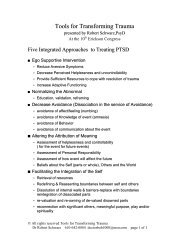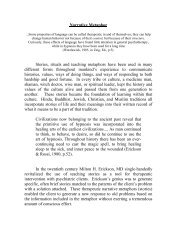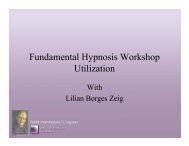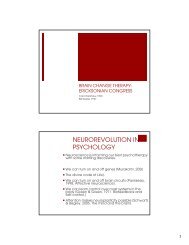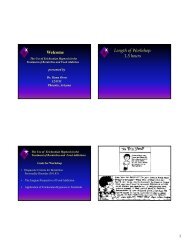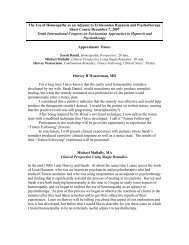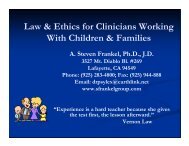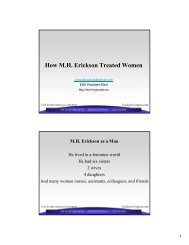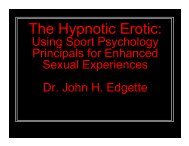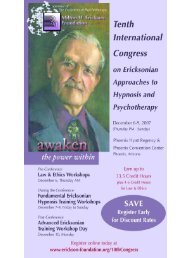Indirect Suggestions & Binds
Indirect Suggestions & Binds
Indirect Suggestions & Binds
Create successful ePaper yourself
Turn your PDF publications into a flip-book with our unique Google optimized e-Paper software.
<strong>Indirect</strong> <strong>Suggestions</strong> & <strong>Binds</strong>:<br />
Formulas<br />
1. Open Ended <strong>Suggestions</strong>:<br />
Increase one level of ambiguity.<br />
2. Presuppostion:<br />
Use syntax of presupposition, name goal and end quickly.<br />
3. Focus Awareness:<br />
Use questions or statements and name goal.<br />
4. Truism:<br />
Start with cultural truism about the goal and name goal.<br />
5. All Possible Alternatives:<br />
Use the form: "a" or "b" or "c" or "d" or "e" or not.<br />
6. Apposition of Opposites:<br />
This (goal) changes as that (other) changes in an opposite way.<br />
7. <strong>Binds</strong> of Comparable Alternatives:<br />
You can either do _X_ or _Y_ (but either is a subset of _Z_).<br />
8. Conscious / Unconscious Bind:<br />
The conscious mind can ___ as the unconscious does ___.<br />
9. Double Dissociative Cons. / Unconsc.<br />
The conscious mind can _X_ as the unconscious does _Y_ or else<br />
the conscious mind can _Y_ as the unconscious does _X_.<br />
10. Non-Sequitur <strong>Binds</strong>:<br />
"A" (goal) or "A'" (A' is "A" rephrased).<br />
Copyright © 1987-2005 Stephen Lankton, P.O. 9489, Phoenix, AZ 85068<br />
Page 18
1. Open ended:<br />
Increase one level of ambiguity.<br />
2. Implication:<br />
Use syntax of presupposition, name goal and end.<br />
3. Focus awareness:<br />
Use questions or statements and name goal.<br />
4. Truism:<br />
Start with cultural truism about goal and name goal.<br />
5. All possible alternatives:<br />
Use the form: "a" or "b" or "c" or "d" or "e" or not.<br />
6. Apposition of opposites:<br />
<strong>Indirect</strong> <strong>Suggestions</strong> Decoded<br />
This (goal) changes as that (other) doesn't.<br />
Copyright © 1987-2005 Stephen Lankton, P.O. 9489, Phoenix, AZ 85068<br />
Page 19
Copyright © 1987-2005 Stephen Lankton, P.O. 9489, Phoenix, AZ 85068<br />
<strong>Indirect</strong> <strong>Binds</strong> Decoded<br />
7. <strong>Binds</strong> of comparable alternatives:<br />
You can either do _X_ or _Y_ (but either is a subset of<br />
_Z_).<br />
8. Conscious / unconscious bind:<br />
The conscious mind can ___ as the unconscious does ___.<br />
9. Double dissociative cons / Unc.:<br />
The conscious mind can _X_ as the unconscious does _Y_<br />
or else the conscious mind can _Y_ as the unconscious does<br />
_X_.<br />
10. Non-sequitur binds:<br />
"A" (goal) or "A'" (A' is "A" rephrased).<br />
Page 20
1. Open ended suggestions<br />
<strong>Indirect</strong> <strong>Suggestions</strong> & <strong>Binds</strong>:<br />
Examples 1<br />
Beginning orientation: “Chairs were intended to be comfortable and serve a function.”<br />
Developing trance: “Hypnosis is a way of learning about yourself at a different level of being.”<br />
Arm levitation: “A person can show a wide variety of movement and posture.”<br />
Age regression: “Your personal history is rich with a wide range of experience.”<br />
Learn from experience: “You can develop a line of thought for your own use.”<br />
Use learning after trance: “An experience can be represented in various ways over time.”<br />
2. Implication<br />
Beginning orientation: “Since you began when you arrived in my office...”<br />
Developing trance: “The first thing people do when they go into trance...”<br />
Arm levitation: “Before you find out if your arm raises all the way to your face...”<br />
Age regression: You may find the most influential experience of your childhood.”<br />
Learn from experience: “Which lesson do you imagine you will learn first?”<br />
Use learning after trance: “The more you find ways to use the learnings now the more you’re likely to use them<br />
each year.”<br />
3. Questions or statements that focus or reinforce awareness<br />
Beginning orientation: “I wonder if you experience yourself ready to begin.”<br />
Developing trance: “Have you been in trance before?”<br />
Arm levitation: “Can you feel your arm getting lighter.”<br />
Age regression: “One might wonder what five year old experience will be remembered.”<br />
Learn from experience: “What can a person learn from an experience?”<br />
Use learning after trance: “Have you decided when you’ll use this learning?”<br />
4. Truisms<br />
Beginning orientation: “You’ve always had your own thoughts.”<br />
Developing trance: “Each person goes into trance in a unique manner.”<br />
Arm levitation: “Sooner or later you will want to raise an arm up in the air.”<br />
Age regression: “Everybody knows what the world was like at five.”<br />
Learn from experience: “Experience is a great teacher.”<br />
Use learning after trance: “Everyone knows the importance of doing some homework”.<br />
5. <strong>Suggestions</strong> which cover all possible alternatives<br />
Beginning orientation: “You might be able to sit there with your arms on your lap or folded, with your hands apart<br />
Copyright © 1987-2005 Stephen Lankton, P.O. 9489, Phoenix, AZ 85068<br />
Page 21
<strong>Indirect</strong> <strong>Suggestions</strong> & <strong>Binds</strong>:<br />
Examples 2<br />
or together, with your feet flat on the floor or crossed, with your eyes open or closed, or find comfort in some<br />
other way.”<br />
Developing trance: “You can go into trance slowly, gradually, suddenly, with your eyes open or closed, or not at<br />
all.”<br />
Arm levitation: “Your arm may raise up to your face, it may stay right there, it may float up half way to your face,<br />
it may raise only slightly, it may get heavier and drop, or it may find its own unique location.”<br />
Age regression: “A time may be selected, or it may be prescribed; it may come into your mind or only intuitively<br />
occur to you; you may not know at all what age you’ll select.”<br />
Learn from experience: “You may learn some of all of the material, and you may know what you learn or not know<br />
what you learn, and you might learn nothing at all.”<br />
Use learning after trance: “You may not use this or you might use this learning; you might modify it when you use<br />
it; and you can use all of it or only part of it; or you might mix the distinction between what you learn and<br />
what you invent.<br />
6. Apposition of opposites<br />
Beginning orientation: “The longer time we take beginning the sooner you may get to the solution.”<br />
Developing trance: “The more you are able to notice the tension the more your capacity to concentrate on relaxation.”<br />
Arm levitation: “The lighter the left arm becomes the heavier the right arm may feel.”<br />
Age regression: “The older you feel the younger your thoughts may often be.”<br />
Learn from experience: “The more you have been in the dark the more enlightening a learning may be.”<br />
Use learning after trance: “The more rapidly you experience relief from, the problem, the more you will enjoy<br />
using it throughout your vast future.”<br />
7. <strong>Binds</strong> of comparable alternatives<br />
Beginning orientation: “Would you prefer to have me begin talking or would you prefer to begin talking?”<br />
Developing trance: “You may develop trance immediately or gradually.”<br />
Arm levitation: “Perhaps your left arm or maybe it’s your right arm will raise up toward your face.”<br />
Age regression: “I don’t know if you will recall something during your fifth year or something during your sixth.”<br />
Learn from experience: “You may learn from the experience in the trance or perhaps during a dream at night.”<br />
Use learning after trance: “You can use this learning in a carefully planned way or in a more creative fashion<br />
as you leave the trance session.”<br />
8. Conscious/unconscious double binds<br />
Beginning orientation: “The conscious mind may be curious about how your unconscious mind is beginning to work<br />
toward a solution.”<br />
Developing Trance: “Your conscious mind may think you desire or need one level of trance while your unconscious<br />
mind develops the proper depth of trance.”<br />
Arm levitation: “Your conscious mind may not notice how your unconscious will raise your arm up to your face.”<br />
Copyright © 1987-2005 Stephen Lankton, P.O. 9489, Phoenix, AZ 85068<br />
Page 22
<strong>Indirect</strong> <strong>Suggestions</strong> & <strong>Binds</strong>:<br />
Examples 3<br />
Age regression: “Your conscious mind can recall some important early experience while your unconscious mind<br />
develops a reliving of it.”<br />
Learn from experience: “An unconscious learning from the experience may be developed in the conscious mind<br />
as well.”<br />
Use learning after trance: “Your conscious mind might already have some ideas of where you will use this while<br />
your unconscious handles the job of doing it correctly.”<br />
9. Double dissociative conscious/unconscious double binds<br />
Beginning orientation: “Your conscious mind may have begun with the aid of your unconscious or perhaps your<br />
unconscious is ready to begin with any aid you can offer consciously.”<br />
Developing trance: “Your conscious mind may focus on some one spot while your unconscious initiates trance or<br />
your unconscious may select the actual location on which to focus your attention while your conscious mind<br />
helps you go into trance.<br />
Arm levitation: “Your conscious mind can choose which arm to raise up while your unconscious makes alterations<br />
in sensation, but perhaps the unconscious mind selects which arm to raise and the conscious mind will notice<br />
the sensation.”<br />
Age regression: “Your unconscious may allow you to relive some aspect of your past while your conscious mind<br />
has a learning about it or maybe your unconscious mind will store a learning while you consciously remember<br />
and relive the past experience.”<br />
Learn from experience: “Your conscious mind can be interested in what you learn from the experience and your<br />
unconscious mind can take care of really learning from it, or perhaps your unconscious mind only allows<br />
you to develop interest as your conscious mind develops a learning.”<br />
Use learning after trance: “And one might let the conscious mind select the site for using the learning while the<br />
unconscious is trusted to carry it out, or one may allow the conscious mind to carry out a learning and let the<br />
unconscious select the location, and time.”<br />
10. Non-sequitur double bind<br />
Begin Orientation: “Let’s begin now or use the time constructively.”<br />
Developing trance: “You may be able to either go into trance as we speak or you will alter your consciousness and<br />
experience.”<br />
Arm levitation: “Your unconscious will either raise the hand off your lap or your conscious mind will notice it half<br />
way to your face.”<br />
Age regression: “The memory may be from the age of five or about the time you entered grammar school.”<br />
Learn from experience: “You can either learn from this experience or use the learning in a directed fashion<br />
for our own benefit.<br />
Use learning after trance: “Will you use these learnings after trance or change your maladaptive behavior?”<br />
Copyright © 1987-2005 Stephen Lankton, P.O. 9489, Phoenix, AZ 85068<br />
Page 23




